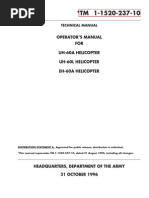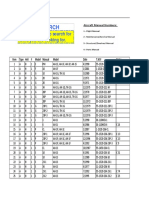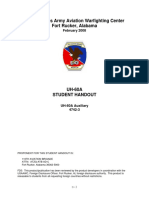0 ratings0% found this document useful (0 votes)
885 viewsUh60 Cockpit Info
Uh60 Cockpit Info
Uploaded by
auger0_0The following information is provided to assist fire fighters and emergency medical personnel in locating emergency fuel shut off, flight crew egress locations. The fuel type for The UH-60 is JP-4, JP-8, or Jet A with a total capacity of360 gallons. To shut off the power control levers, the levers need to be grabbed and pulled downward while holding down the push to release thumb switches.
Copyright:
Attribution Non-Commercial (BY-NC)
Available Formats
Download as PDF, TXT or read online from Scribd
Uh60 Cockpit Info
Uh60 Cockpit Info
Uploaded by
auger0_00 ratings0% found this document useful (0 votes)
885 views8 pagesThe following information is provided to assist fire fighters and emergency medical personnel in locating emergency fuel shut off, flight crew egress locations. The fuel type for The UH-60 is JP-4, JP-8, or Jet A with a total capacity of360 gallons. To shut off the power control levers, the levers need to be grabbed and pulled downward while holding down the push to release thumb switches.
Original Title
uh60 Cockpit info
Copyright
© Attribution Non-Commercial (BY-NC)
Available Formats
PDF, TXT or read online from Scribd
Share this document
Did you find this document useful?
Is this content inappropriate?
The following information is provided to assist fire fighters and emergency medical personnel in locating emergency fuel shut off, flight crew egress locations. The fuel type for The UH-60 is JP-4, JP-8, or Jet A with a total capacity of360 gallons. To shut off the power control levers, the levers need to be grabbed and pulled downward while holding down the push to release thumb switches.
Copyright:
Attribution Non-Commercial (BY-NC)
Available Formats
Download as PDF, TXT or read online from Scribd
Download as pdf or txt
0 ratings0% found this document useful (0 votes)
885 views8 pagesUh60 Cockpit Info
Uh60 Cockpit Info
Uploaded by
auger0_0The following information is provided to assist fire fighters and emergency medical personnel in locating emergency fuel shut off, flight crew egress locations. The fuel type for The UH-60 is JP-4, JP-8, or Jet A with a total capacity of360 gallons. To shut off the power control levers, the levers need to be grabbed and pulled downward while holding down the push to release thumb switches.
Copyright:
Attribution Non-Commercial (BY-NC)
Available Formats
Download as PDF, TXT or read online from Scribd
Download as pdf or txt
You are on page 1of 8
DEPARTMENT OF THE ARMY
ARIMY AVIATION SUPPORT FACILITY
VIRGINIA ARMY NATIONAL GUARD
700 PORTUGEE ROAD
'SANDSTON, VIRGINIA 23150-5050
IFHQ-VAAV-OT-AS 29 October 2008
MEMORANDUM FOR RECORD
SUBJECT: UH-60 Emergency Egress Procedures and Fucl Shut Off Location
1, The following information is provided to assist fire fighters and emergency medical personnel in locating.
‘emergency fuel shut off, Hight crew egress locations, as well as information pertaining to fuel type, amount, and
battery location.
2. ‘The UH-60 is a medium lift dual engine helicopter designed to operate from prepared and unprepared landing
areas. The fuel type for the UH-60 is JP-4, JP-8, or Jet A wih a total capacity of 360 gallons,
3. The throttles for the UH-60 consist of two power control levers located on the upper/overhead console between
the pilot and co-pilot seats. When the aircraft is in operation, the power control levers are fully open in the FLY
dotent / forward position, To sbut off the power control levers, the levers need to be grabbed and pulled downward
while holding down the push to release thumb switches (one on each power control lever). ‘The push to release
thumb switches are held when moving the power control levers off to prevent the levers stopping in the idle
position,
4, Fuel system selector levers are located on the upper/overhead console next to the power control levers between
the pilot and co-pilot seats, Pulling the fuel system selector levers full aft will shut off the fuel supply (o the aircraft
engine.
5. The UH-60 has two engine emergency off T-handles used to fight engine fires. These emergency T-handles are
located on the upperioverhead console in front of the fuel system selector levers between the pilot and co-pilot seats
Pulling the engine emergency off T-handles full at will shutoff the fuel supply to the aircraft engines by pulling the
fuel system selectors off, Additionally, the T-handles will provide fire fighting capabilities to the aireraft by an
clectrical logic module providing electrical power to actuate the fie extinguisher switch
5. The UH-60 battery location is located behind the co-pilot’s seat (left side of the aircraft) underneath a battery box
‘cover, The battery is a 28 volt sealed lead acid battery (SLAB) type with a twist to tun as a quick disconnect.
6. Airoralt consists of four doors for entry and exits. Doors are of bonded sheet metal with acrylie plastic windows.
‘The piloveo-pilot doors may be jettisoned by means of an emergency handle. ‘The eabin doors have windows that
can be jettisoned by means of an emergency handle
7. Approaching or exiting the aircraft should be completed by the left or right sides of the aircraft. This is due to
possible problems occurring with the main rotor blades drooping downward providing only 4 feet of clearance upon
level surface. Always avoid the aircraft tal rotor!
4 Enels RONALD J.
1. Fig 2-3 (4 pages) CW4, Vaal
2, Fig 2-7 (Shoot | of 2) AASE ASOKP:
3. Fig 2-13
4, Fig 2-8 (Sheet 1 of 3)
UH-60L Black Hawk
I. Approaching or Exiting Aircraft:
A. Blades turning (functioning properly) . . we
1. main rotor shaft has 3 degrees of forward tilt
2. blades will flap leaving 7 to 9 feet clearance at forward most
section decreased or increased by terrain
3. be aware of the wind it will induce flapping
4. exit to right rear or left rear for greatest rotor clearance
5. always avoid tail rotor, approximately 6 feet clearance
increased or decreased by terrain
B. Blades turning (not functioning properly) ie. droop stops don’t
come in
1. main rotor blades may droop leaving only 4 feet clearance
increased or decreased by terrain
2. rotor blades may contact aft fuselage
3. be aware of the wind it will induce flapping
4. exit to right rear or left rear for greatest rotor clearance
5. always avoid tail rotor
+ Tau novon m onmtenz: ween
PARAPLAE RE yeEeET OES
eet eames vag
Figure 2-3. Turning Radius and Clearance
Th.
Emergency shutdown procedures for engines
A. Two main engines
Steps: . wos
1, Engine Power Control lever(s) OFF
2. Engine Fuel System selector(s) OFF
3. Fuel Boost Pump Control switch(es) OFF
B. One Auxiliary Power Plant (APU)
Steps:
1. Fuel Pump switch ~ Off
2. APU Control Switch ~ Off
Fire fighting emergency procedures
A. Main Engine / Fuselage Fire On Ground
Steps
1. Engine Power Control levers Off
1, Engine Emergency Off handle Pull if applicable
2. Fire Extgh switch Main /Reserve, as required
B, APU Compartment Fire
Steps:
1, APU fire T-handle Pull
2. Fire Extgh switch ~ Main / Reserve as required
FYI: There is a Crash-Actuated System as part of the fire
extinguisher system that will automatically fire both fire extinguishing
containers into both engine compartments upon impact of a crash of
10 Gs or more.
IV. Emergency Exits: Emergency exit release handles are yellow and
black striped.
A. Two pilot doors / cockpit doors (doors swing outward are hinged
and have a latch handle)
« _ L. (cockpit door jettison system)
a. pull handle marked EMERGENCY EXIT PULL to the
rear
b. from inside, kick lower forward comer to jettison
2. (cockpit door window jettison system)
a. pull window emergency strap inward
b. windows remove to the inside
B. Two troop/cargo -cabin- doors two windows per door (doors slide,
have single action door latches,and will latch in fully open or
locked position)
1. (cabin door window jettison system)
a, pull lever marked EMERGENCY EXIT PULL
ALT (left side) or EMERGENCY EXIT PULL FWD
(right side)
c. move handle in the direction of arrow to release
windows
d. remove windows to the outside
C. Two crew chief / gunner windows (windows slide are hatch
windows split vertically into two panels, spring loaded security
Jatch and dead bolt lock only useable from the inside, latch bar to
secure window open)
1. not considered an emergency exit by the operators manual
2. must be in the opened position to move machinegun and/or
mount outward for pilot seat release
D. Operation of machinegun pintle-mount
1. Attached with quick release pin
2..To rotate lift T-handle on rear of mount and rotate,
3. pintle-mount must be positioned out of the gunner window
for the pilot seats to recline
V. Operation of pilot and copilot seat adjustments and emergency
levers.
A. Seat Adjustments
1. Verti
2.
al seat height lever on right front of seat bucket
a, spring loaded to locked position when réleased
b. springs are installed to counterbalance the weight of the seat
c. DO NOT RELEASE UNLESS SOMEONE IS SITTING
IN THE SEAT
4. Spring preload could be as high as 150 pounds, with no one
in the seat it will spring to highest position
Forward and Rear adjustment lever on left front of seat bucket
a. spring loaded to locked position when released
B. Seat emergency levers
1.
2.
Emergency tilt levers on cach side of seat support frame
a. allows séat to tilt back into cabin
D. seat must be in full down and aft position
c. push in on tilt handle
d. pull seat top rearward
Emergency vertical release lever on upper center back of seat
a. allows seat to drop to lowest adjustment point
b. pull right on seat lever !
©
C.. Seat belts
1.
2.
3.
4
shoulder harness, seat belt, crotch strap
common buckle assemble
single point release (lift lever or rotary release)
lift lever or turn rotary release and straps release
simultaneously
Ti 1-1820.297-10
Figure 2-7. Upper Console (Sheet 1 of 2)
‘Te 4-1520-237-10
sseconoany
BLESTOP
You might also like
- Op Manual UH-60A UH-60L EH-60A HelicopterDocument841 pagesOp Manual UH-60A UH-60L EH-60A HelicopterSpace_Hulker100% (6)
- Operators Manual TM 1-1520-237-10 PDFDocument902 pagesOperators Manual TM 1-1520-237-10 PDF조동훈100% (1)
- TM 55-1520-210-23-1Document1,300 pagesTM 55-1520-210-23-1Leonardo Gonzalez Rocha100% (10)
- AFCSDocument34 pagesAFCSMuralidharan ShanmugamNo ratings yet
- UH60 Power Train and Rotor SystemDocument29 pagesUH60 Power Train and Rotor Systemeivmu100% (2)
- The First Helicopter Boys: The Early Days of Helicopter Operations—The Malayan Emergency, 1947–1960From EverandThe First Helicopter Boys: The Early Days of Helicopter Operations—The Malayan Emergency, 1947–1960No ratings yet
- UH60A IntroductionDocument15 pagesUH60A IntroductionAbdul Azim Afiq Dolbaharin100% (1)
- TM 1-1520-237-10Document837 pagesTM 1-1520-237-10Lowell SmithNo ratings yet
- TM 1-1520-237-10 - UH.60 - and - EH-60 - Helicopter - 2009Document902 pagesTM 1-1520-237-10 - UH.60 - and - EH-60 - Helicopter - 2009Wurzel1946100% (1)
- Operator'S and Crewmember'S Checklist Uh-60A Helicopter Uh-60L Helicopter Eh-60A HelicopterDocument137 pagesOperator'S and Crewmember'S Checklist Uh-60A Helicopter Uh-60L Helicopter Eh-60A HelicopterJim-Emmanuel MascarinasNo ratings yet
- TM 1 1520 237 MTF Maintenance Test Flight Manual Uh 60a Helicopter Uh 60l Helicopter Eh 60a Helicopter 31 March 1997Document251 pagesTM 1 1520 237 MTF Maintenance Test Flight Manual Uh 60a Helicopter Uh 60l Helicopter Eh 60a Helicopter 31 March 1997k_goulasNo ratings yet
- TM 55 1520 236 23 4Document239 pagesTM 55 1520 236 23 4Tod A. Wulff100% (3)
- TM 1-1520.237 Maintenance Test Flight Manual HeloDocument251 pagesTM 1-1520.237 Maintenance Test Flight Manual Helotmt IngNo ratings yet
- TM 55-1520-237-23P-1Document829 pagesTM 55-1520-237-23P-1Anonymous 4nZmYTzNo ratings yet
- TM1 1520 237 23 13Document705 pagesTM1 1520 237 23 13joel alvarado100% (1)
- JHMCS-D 2002Document83 pagesJHMCS-D 2002omerfltNo ratings yet
- This Manual Supersedes TM11 1520 237 23 1, Dated 15 June 1994, Including All ChangesDocument748 pagesThis Manual Supersedes TM11 1520 237 23 1, Dated 15 June 1994, Including All ChangesRodriguez Cristian0% (1)
- UH-60 L BookletDocument18 pagesUH-60 L Bookletcho kang ho100% (1)
- Army CH-47 Chinook HelicopterDocument714 pagesArmy CH-47 Chinook HelicopterArmySGT100% (4)
- TM 55-1520-228-BD PDFDocument312 pagesTM 55-1520-228-BD PDFAnselmo Alvarez Gonzalez100% (2)
- JHMCS-D 2002Document83 pagesJHMCS-D 2002MeNo ratings yet
- A Mathematical Model of The UH-60 HelicopterDocument46 pagesA Mathematical Model of The UH-60 HelicopterSplash1100% (1)
- TM 1 1520 236 CLDocument39 pagesTM 1 1520 236 CLTod A. WulffNo ratings yet
- Aircraft Manual IndexDocument41 pagesAircraft Manual IndexGhribi100% (2)
- TM 1-1520-237-23p-2 - Fig69Document2 pagesTM 1-1520-237-23p-2 - Fig69augustinhodjNo ratings yet
- TM1 1520 237 23 14Document688 pagesTM1 1520 237 23 14joel alvaradoNo ratings yet
- UH-60 Blackhawk NASA TestsDocument18 pagesUH-60 Blackhawk NASA TestsmaverickF15No ratings yet
- TM1-1520-237-23-19 2Document809 pagesTM1-1520-237-23-19 2joel alvarado100% (1)
- TM 1-1520-236-10 (2001 - 0126) Operators Manual, AH-1FDocument360 pagesTM 1-1520-236-10 (2001 - 0126) Operators Manual, AH-1FOlgerd1977100% (1)
- TM 55 1520 228 23 1Document1,115 pagesTM 55 1520 228 23 1Evert ̶C̶a̶r̶l̶o̶s̶100% (1)
- fm3 04x140Document368 pagesfm3 04x140Firebrand38100% (1)
- UH-60A Auxiliary Student HandoutDocument32 pagesUH-60A Auxiliary Student Handout안정열100% (1)
- Handout - AFCSDocument21 pagesHandout - AFCS김종환No ratings yet
- TM 1 1520 237 23 1Document569 pagesTM 1 1520 237 23 1Anonymous Kn5uYJ67% (3)
- Uh60 MalfunctionDocument41 pagesUh60 MalfunctionJ Q100% (1)
- UH-60 Related DocumentDocument136 pagesUH-60 Related DocumentRobert WangNo ratings yet
- 052892Document84 pages052892starsalingsoul8000No ratings yet
- TM - 55 1500 345 23 PDFDocument515 pagesTM - 55 1500 345 23 PDFRobert Davis0% (1)
- UH60A T700 Engine (Análisis Funcional)Document50 pagesUH60A T700 Engine (Análisis Funcional)Alejandra QuirozNo ratings yet
- Army Aviation Digest - Apr 1988Document48 pagesArmy Aviation Digest - Apr 1988Aviation/Space History LibraryNo ratings yet
- TM 1-S70i-280-MTFDocument240 pagesTM 1-S70i-280-MTF58ycmfk2sqNo ratings yet
- Handout - Fuel SystemDocument20 pagesHandout - Fuel System김종환No ratings yet
- TM - 9 1427 475 30Document15 pagesTM - 9 1427 475 30Costas MoraitisNo ratings yet
- TM 55 1520 236 T 2Document997 pagesTM 55 1520 236 T 2Tod A. Wulff100% (2)
- TM1 1520 237 23 10Document364 pagesTM1 1520 237 23 10joel alvaradoNo ratings yet
- Virtavia Black Hawk ManualDocument66 pagesVirtavia Black Hawk ManualMarcio N AmaralNo ratings yet
- Compliance With This Publication Is Mandatory AccessibilityDocument257 pagesCompliance With This Publication Is Mandatory AccessibilityKonstantin SusdaltzewNo ratings yet
- TM 1-1520-236-MTF - Helicopter - AH-1 - Cobra - 2001 PDFDocument165 pagesTM 1-1520-236-MTF - Helicopter - AH-1 - Cobra - 2001 PDFWurzel1946No ratings yet
- TM 1-1520-256-23 PDFDocument522 pagesTM 1-1520-256-23 PDFEagle1968100% (2)
- TM 55 1510 220 10 PDFDocument455 pagesTM 55 1510 220 10 PDFRobert DavisNo ratings yet
- MCH 011 - US Navy - HH-60G Helicopter Fundamentals - 1997Document170 pagesMCH 011 - US Navy - HH-60G Helicopter Fundamentals - 1997hannoverfisk100% (3)
- TM 11-1520-237-23-2 Em0014 30may2014 PDFDocument827 pagesTM 11-1520-237-23-2 Em0014 30may2014 PDFjoel alvaradoNo ratings yet
- From Auster to Apache: The History of 656 Squadron RAF/ACC 1942–2012From EverandFrom Auster to Apache: The History of 656 Squadron RAF/ACC 1942–2012No ratings yet
- Maryland, Virginia, and Washington D.C. Warbird Survivors 2003: A Handbook on Where to Find ThemFrom EverandMaryland, Virginia, and Washington D.C. Warbird Survivors 2003: A Handbook on Where to Find ThemNo ratings yet
- Aerospace Actuators 1: Needs, Reliability and Hydraulic Power SolutionsFrom EverandAerospace Actuators 1: Needs, Reliability and Hydraulic Power SolutionsNo ratings yet



























































